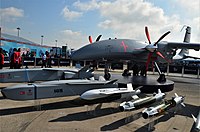History of unmanned combat aerial vehicles

Well kiddo, unmanned combat aerial vehicles (UCAVs) are like the high-tech versions of your toy remote controlled car. They are planes that can fly without having a pilot inside them – pretty cool, right?
But UCAVs weren't always used for combat. They started out as basic surveillance planes that the military would use to spy on other countries or even monitor their own troops. They were really helpful in finding out important information without putting any pilots in danger.
But later, when countries started to go to war, people realized that these unmanned planes could also be used as weapons. This was a big deal because it meant that countries could fight without risking the lives of their pilots.
The first UCAVs were developed in the 1980s, and they were pretty simple. They could only carry a few small bombs and weren't very accurate. But as technology improved, so did UCAVs. The US military started using them more and more in the 1990s, and other countries started developing their own versions too.
Nowadays, UCAVs can carry all sorts of weapons, from missiles to bombs to even guns. They can fly for hours or even days without needing to refuel. And they can be controlled from anywhere in the world – someone in a military base on one side of the planet could be controlling a UCAV flying on the other side!
So there you have it – the history of unmanned combat aerial vehicles. From simple spy planes to high-tech weapons, UCAVs have come a long way in just a few decades.
But UCAVs weren't always used for combat. They started out as basic surveillance planes that the military would use to spy on other countries or even monitor their own troops. They were really helpful in finding out important information without putting any pilots in danger.
But later, when countries started to go to war, people realized that these unmanned planes could also be used as weapons. This was a big deal because it meant that countries could fight without risking the lives of their pilots.
The first UCAVs were developed in the 1980s, and they were pretty simple. They could only carry a few small bombs and weren't very accurate. But as technology improved, so did UCAVs. The US military started using them more and more in the 1990s, and other countries started developing their own versions too.
Nowadays, UCAVs can carry all sorts of weapons, from missiles to bombs to even guns. They can fly for hours or even days without needing to refuel. And they can be controlled from anywhere in the world – someone in a military base on one side of the planet could be controlling a UCAV flying on the other side!
So there you have it – the history of unmanned combat aerial vehicles. From simple spy planes to high-tech weapons, UCAVs have come a long way in just a few decades.
